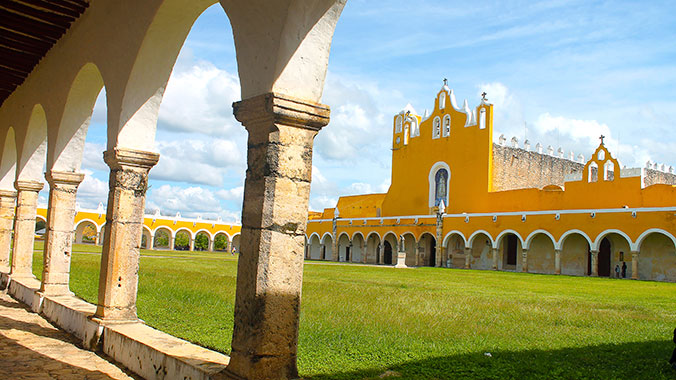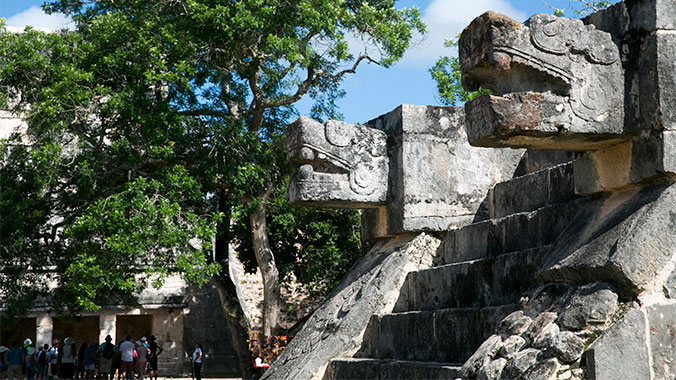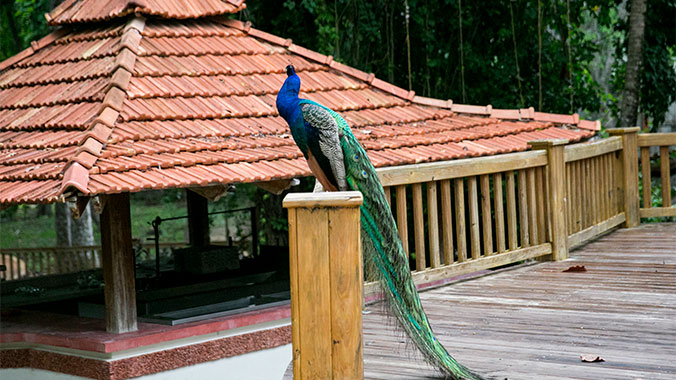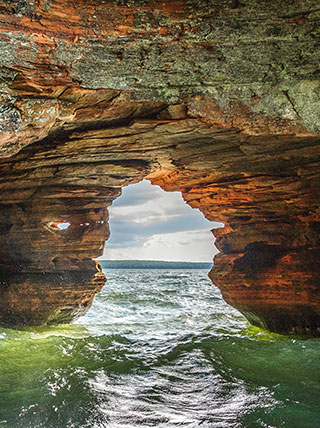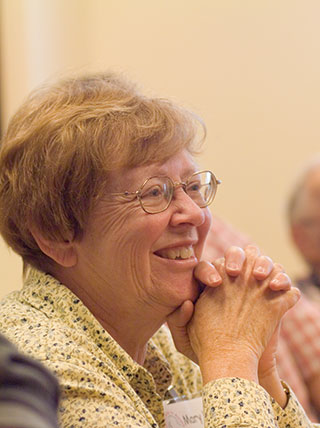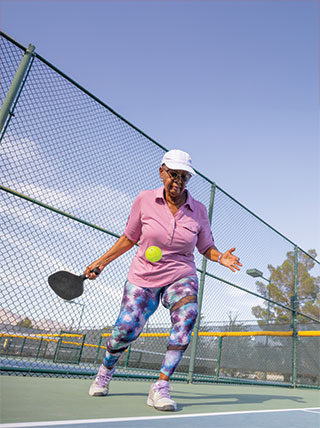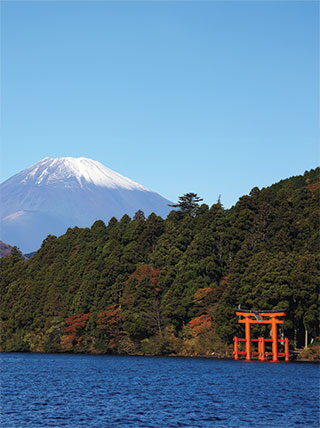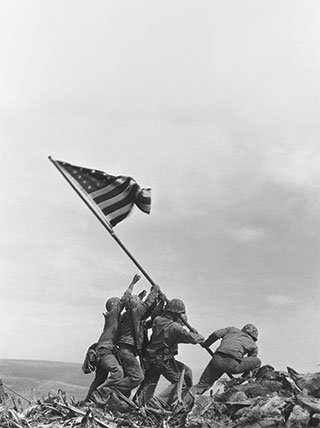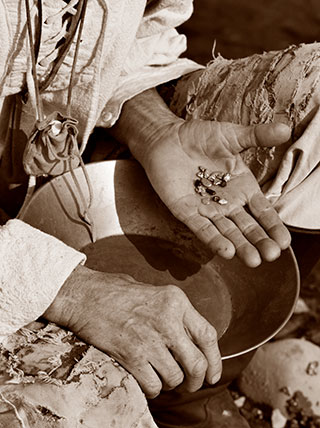
The Legacy of the Maya: Archaeology of the Northern Yucatan
Enroll with Confidence
We want your Road Scholar learning adventure to be something to look forward to—not worry about. Learn more
Protecting the Environment
We offset a portion of the emissions created by your travel. Learn more
At a Glance

What You'll Learn
- Get an archaeologist-led look into investigating Maya sites as you explore the Pre-classic city of Kiuic.
- Discover how the Maya built their pyramidal structures at Uxmal, considered by many to be one of the most beautiful Maya sites.
- Delve into Itza and Maya history at Chichen Itza, known for the Kukulkan pyramid that served as an astronomical calendar for the Maya.

Please note: This expert may not be available for every date of this program.

Activity note: Hotel check-in from 3:00 p.m. See your program’s “Getting There” information regarding transfers. Remember to bring your nametag (sent previously).
Afternoon: After arriving at the hotel and checking in, take some time to freshen up and relax before our Orientation session. Orientation: 6:30 p.m. The Group Leader will greet everyone and lead introductions. We will review the up-to-date program schedule, discuss roles and responsibilities, logistics, safety guidelines, emergency procedures, and answer questions. We will review protocols and will adhere to applicable requirements and guidelines throughout the program. Program-related travel and transfers will be via air-conditioned bus (with several steps up/down) unless specified otherwise. The bus does not have a restroom on board; however, there will be stops at least every two hours for program activities, meals, and/or basic rest stops to break up longer travel times. Periods in the schedule designated as “Free time” and “At leisure” offer opportunities to do what you like and make your experience even more meaningful and memorable according to your personal preferences. The Group Leader will be happy to offer suggestions. Program activities, schedules, personnel, and indicated distances or times may change due to local circumstances/current conditions. In the event of changes, we will alert you as quickly as possible. Thank you for your understanding.
Dinner: At the hotel, enjoy a Welcome Dinner.
Evening: We’ll gather with our Group Leader for a presentation on Spanish and Maya language tips. Continue getting to know your fellow Road Scholars, settle in, and get a good night’s rest for the day ahead. Prepare for check-out and transfer in the morning.
Activity note: Getting on/off a bus; driving about 236 miles, approximately 4 - 4.5 hours total riding time. Walking on mostly flat terrain, unpaved paths, cobble stones, grassy expanses, some steps. Wear walking shoes, sunscreen, sunglasses, hat, and bring a bathing suit in case you wish to swim in the cenote after lunch.
Breakfast: At the hotel.
Morning: We will check-out of our hotel and board a bus that will take us to the Ek Balam Ruins. Our Group Leader will take us on an exploratory walk through the complex highlighting important imagery, architectural features, and their historical context. Located about 15.5 miles north of Valladolid, the excavated portion is small but contains a magnificent palace structure with life-sized stucco statuary reminiscent of sites further south. The white temple served as the final resting place for the great king, Father of Four Hard Flints (Ukit Kan Le’k Tok’) during whose reign many of the buildings were constructed. In addition to the Chenes-style earth monster mask and other beautiful imagery, it is possible to observe a small painted mural, visible on a door frame and depicting figures ascending pyramid steps. A newly discovered statue of an important woman is located on the same level as the white temple. The emblem glyph of Ek Balam is also clearly visible at the bottom of the palace structure. The site is walled and contains a four-sided arched entry as well as twin buildings, important stelae and a ball-court. Once we are done walking through the ruins, we will board bici-taxis (a type of bicycle-rickshaw) and transfer to the large cenote located near the core of Ek Balam in preparation for lunch.
Lunch: At a restaurant near the cenote, we’ll have a traditional Maya meal.
Afternoon: We will have an opportunity to cool off with a refreshing dip in the cenote. We’ll then board our bus and ride on to Merida. Upon late afternoon arrival, we’ll explore the city’s Palacio del Gobierno to view its famous murals by revered Mexican artist Fernando Castro Pacheco (1918-2013) who was from Merida. The images depict important historical events such as the arrival of the Spanish and their interactions with the Maya. Castro Pacheco expressed deep nationalist themes in his art, featuring imagery and historic perspectives reflecting his Yucatecan origins. We’ll then proceed to the hotel for check in.
Dinner: At a local restaurant.
Evening: At leisure.
Activity note: Getting on/off a bus; driving about 60 miles throughout the day; approximately 2 1/2 hours total riding time. Walking up to 2 hours on mostly flat, paved surfaces; some cobbled stones, steps, and grassy unpaved paths.
Breakfast: At the hotel restaurant.
Morning: We'll accompany our Group Leader on a walking exploration of Merida Market and the Xcambo ruins. At the end of our field trip, we'll board a bus and ride to Progreso for lunch.
Lunch: At a restaurant in Progreso overlooking the turquoise-colored waters of the Gulf of Mexico.
Afternoon: Next, we will ride back to Merida for some “siesta” time. Later in the afternoon, we’ll head out on a walking field trip to the City Museum. We’ll then return to the hotel for a presentation by our Group Leader on Mesoamerican prehistory from the Olmecs to the Aztecs and putting the Maya in perspective.
Dinner: This meal has been excluded from the program cost and is on your own to enjoy what you like. The Group Leader will be happy to offer suggestions.
Evening: At leisure.
Activity note: Getting on/off a bus; driving about 134 miles throughout the day with stops, approximately 3 hours total riding time. Walking on cobbled stone streets, ascending/descending stone steps.
Breakfast: At the hotel.
Morning: We will board the bus with our Group Leader and ride to Izamal for a morning of walking field trips in the historic city. Izamal is sometimes called the “yellow” or “golden” city because its buildings are painted golden yellow. It is also known as the “City of Three Cultures” because within its core it is possible to find a blend of ancient, colonial, and modern structures. Izamal appears to have once been a very large Maya city, inhabited from the Preclassic period until the Spanish Conquest, with considerable political, economic, and religious power. It has huge pyramids, still visible, within the city and large sacbes (causeways) connecting to nearby sites. The large cathedral, built during the colonial era, is dedicated to the Virgin of the Immaculate Conception (Our Lady of Izamal). A small onsite museum displays various crowns and dresses prepared for the statue of the Virgin, including those used for the visit of Pope John Paul II. The size of the cathedral atrium is second only to that of St. Peter’s in Rome. The cathedral was constructed atop a pyramid’s platform; parts of the original structure are still visible. The figure of the Virgin is located among beautiful, gilded retablos at the front of the church. A small track allows her effigy to be displayed in the main church or in the small chapel, open to the public, located at the rear of the building. From the atrium, it is possible to see at least three other pyramids lining the ancient, much larger main city plaza.
Lunch: At a local restaurant where we will be able to see tortillas being made.
Afternoon: We will walk to the Kinich K’ahk Mo’ ruins (circa 400-600 C.E.) to view and climb one of the largest temples, by volume, in the Maya world. Once we ascend the stone staircase to the top, we will be able to view other pyramids located within and near the modern city boundaries. From Izamal, we will ride south to Mayapán for a walking field trip at the Maya site. Mayapán was the last Maya regional capital during the Late Postclassic period (1220’s to 1440’s); a city supported by tribute from other noble families and governed by the Cocom family until its overthrow in 1461. Although the construction is Postclassic and not nearly of the caliber of the great city of Chichén Itzá, which it attempts to emulate, it has very important painted plaster murals. Nearby is a large cenote, considered “taboo” by today’s indigenous Maya, and an important sacrificial site in the distant past. Back aboard the motorcoach, we will return to our hotel in Merida. The remainder of the afternoon will be free for independent exploration, spending time with fellow Road Scholars, or just relaxing.
Dinner: On your own to enjoy what you like. The Group Leader will be happy to offer suggestions.
Evening: At leisure. Prepare for check-out and early transfer in the morning.
Activity note: Getting on/off a bus; driving about 80 miles throughout the day, approximately 2.5 hours total riding time. Walking 2-3 hours on undulating, unpaved paths, some steps; important to wear sunscreen, hat, and sunglasses.
Breakfast: At the hotel.
Morning: After check out, we’ll board our bus and ride to Uxmal. Once there, we’ll go on a walking field trip in the ancient Maya city, a UNESCO-designated World Heritage Site. As we examine building architecture and ornamentation, we will learn about the Maya world view, how astronomy ties in with the city’s layout, and how the city collected and stored rainwater. Uxmal, is considered by some archaeologists to be the most beautiful Maya site, especially with regard to its Governor’s Palace, where John Lloyd Stephens and Frederick Catherwood — 19th century explorers who documented many Maya sites — camped while they explored Uxmal and the Puuc region. Uxmal remained in a good state of preservation even before restoration, thus allowing a good understanding of how the city core may have looked in its heyday. At the Pyramid of the Magician, we will see how the Maya built and rebuilt their pyramidal structures: at least 5 layers of construction! We’ll also hear a Maya folktale.
Lunch: At a local restaurant.
Afternoon: Next, we will ride to the Chocolate Museum, where we’ll learn about the cacao tree (Theobroma cacao), the process of making chocolate, and the role this “food of the gods” played in Maya culture. We’ll then have some time to explore on our own before continuing to our hacienda accommodations for check in. Before dinner, we’ll gather for an expert presentation on the Maya calendar, numerology, and hieroglyphics.
Dinner: At the hacienda.
Evening: At leisure.
Activity note: Getting on/off a bus; driving about 72 miles throughout the day with stops, approximately 2.5 hours total riding time. Walking 2.5 hours on undulating paths, grassy and rocky terrain.
Breakfast: Early at the hacienda.
Morning: We will board the bus and ride to the Preclassic Maya site at Kiuic. Led by a local archaeologist, we will explore the ruins and learn about the excavation and its history. We’ll then hike a short distance to the magical House of Diamonds that will take us past a small cave with “natural air conditioning.” This site will help us to better understand why the Maya believed caves and cenotes to be the source of winds and rain so important to their people. We’ll then ride on to the market town of Oxkutzcab.
Lunch: At a local restaurant we'll enjoy a meal featuring typical Yucatecan fare.
Afternoon: After lunch we'll ride to an archaeology lab in preparation for an expert-led field trip. During our visit we will learn about the process of sorting, cataloging, storing, and studying archaeological artifacts. Next, returning to the hacienda, we’ll join our Group Leader for an outdoor discussion on Mexico’s hacienda system and way of life. We’ll learn about the cultural and economic impact of the hacienda model as we explore the historic property on foot.
Dinner: At the hacienda.
Evening: At leisure.
Activity note: Getting on/off a bus; driving about 73 miles throughout the day with stops, approximately 3.5 miles total riding time. Walking about 2.5-3 miles on undulating paths, grassy terrain, ascending/descending stone stairs.
Breakfast: At the hacienda.
Morning: We will get an early start and ride to Kabah for a walking field trip around the ruins with our Group Leader. Kabah is primarily Late Classic (600-900 CE) in age, although it extends back into the Preclassic (1800 BCE-250 CE) period. One of its most impressive buildings is the Codz Poop, with its stacks of Mosaic Chaac masks, indicative of the rain god’s importance in the region. In addition, carved door jambs on the rear of this building illustrate warfare and the capture of captives. Standing images of rulers with outstretched hands, positioned as if to hold an object, give the site its name: kab (hand). There is a palace-like building near the Codz Poop. Across the road lies another very large, unreconstructed pyramid, still covered by a mantle of trees and shrubs and similar in size to some of the largest pyramids at nearby Uxmal. Near this pyramid is an archway that marks the terminus of a sacbe (“white road”) that runs from Uxmal to Kabah. Moving on, we will reach the ruins at Labná. During our field trip, we will examine a large chultun — a Maya cistern for collecting rainwater — still in use. Because of its distance from Mérida, Labná is a site that usually has very few visitors. Despite its small size, it is an impressive, Lateclassic Puuc-style site, renowned for its elaborate arch that was preserved for posterity in the lithographs of Frederick Catherwood. Also impressive is the sacbe joining the arched platform/pyramid complex to the palace-like structures with their symbols of royalty. From Labná, we will ride to the small town of Mani.
Lunch: At a restaurant owned by a living descendant of the last ruling family of Uxmal.
Afternoon: Our next study site will be Mani’s old monastery. The town has a sad claim to fame: it is the place where Friar Diego de Landa carried out the Spanish Inquisition on the indigenous Maya and, in 1562, burned many Maya books and religious figures. The recently restored church has gilded figurines and retablos. At the monastery, we will see faded murals and the noria, built to obtain water from the cenote that the Spanish enclosed. From Mani, we’ll ride to the artisan town of Ticul to see how local pottery is produced and fired. We’ll then ride back to Yunku.
Dinner: A hands-on cooking lesson in the hacienda’s kitchen will give us a practical introduction to Maya culinary traditions. We’ll then enjoy what we helped prepare.
Evening: We’ll gather with Group Leader for a presentation about the geology and geography of the Yucatan. Prepare for check-out and transfer in the morning.
Activity note: Getting on/off a bus; driving about 123 miles throughout the day with stops, approximately 2.5 hours total riding time. Walking about 1 mile on undulating paths.
Breakfast: At the hacienda.
Morning: We will accompany our Group Leader on an informative walk on the hacienda grounds to learn about the property's history as a henequen (sisal) plantation. Then we will check out and prepare luggage for loading onto the bus for the transfer to Valladolid. During the 19th century, henequen's strong and durable fibers were in great demand for making ropes, twine and woven goods. The Yucatan became the main producer of this valuable crop and brought great wealth to merchants and land owners in the area.
Lunch: At a restaurant in Valladolid.
Afternoon: Valladolid is known for its attractive colonial architecture. It is a charming city that usually escapes the hordes who travel to nearby Cancún. Because of its rather isolated location, Valladolid escaped significant royal meddling during the colonial period. The autonomy enjoyed in the town did not come without danger, however. In 1849, Valladolid provided the setting for the Caste War, a conflict in which the native communities of the Yucatán rose up to drive Spanish landlords off the peninsula. The natives came close, but after two months of fighting, the Spaniards subdued the rebellion. Arriving at the hotel, we will check in, then regroup for a walking field trip with our Group Leader through the main square including the municipal palace
Dinner: At the hotel.
Evening: At leisure.
Activity note: Getting on/off a bus; driving about 50 miles, approximately 1 hour riding time. Walking on undulating paths, grassy terrain, ascending/descending stairs, cobbled stone streets. At Chichen Itzá, hot and humid conditions, very little shade. Apply insect repellent, sunscreen, wear hat, sunglasses.
Breakfast: Early at the hotel.
Morning: We will set out early by bus then join our Group Leader on a walking field trip of Chichen Itzá: a UNESCO World Heritage Site. The once powerful city is located in the north-central region of the Yucatan Peninsula. It centers upon two unusually large cenotes: the Xtoloc that provided water for the city and the Sacred Cenote used for religious practices. The visually stunning complex reflects a historically-important fusion of Maya and Toltec styles as can be seen at the Temple of Kukulcan and El Caracol (The Snail) observatory. The forests in and around the impressive archaeological complex are home to a variety of wildlife.
Lunch: At a local restaurant.
Afternoon: En route back to Valladolid, we will stop at the Samula Cenote and take a refreshing dip in the spring-fed waters of the cave pool. Back in the city, we will go on a walking field trip to see more of its historic sites. Like most colonial cities in the Yucatan, Valladolid was born from the destruction of a local Maya community. The very stones used to build the Spanish city once graced the graceful lines of ancient Maya structures. It is sadly ironic perhaps, that many of the original colonial buildings were destroyed or damaged during the Yucatecan Caste War (1847-1901) and later during Indian uprisings. During our walk we'll see the Church of San Bernardino de Siena and the adjoining convent that are among the oldest churches in the region.
Dinner: On your own to enjoy the local fare of your choice.
Evening: At leisure.
Activity note: Getting on/off a bus; driving about 86 miles throughout the day with stops, approximately 3.5 hours total riding time. Walking up to 3 miles on undulating, grassy paths; bici-taxis available for those with walking difficulties at ruins. Walking about 1 mile at reserve; unpaved, irregular terrain with tree roots and rocks.
Breakfast: At the hotel.
Morning: Early this morning, we will ride to Cobá for a walking field trip in the archaeological site. Cobá is a very large city with roots in the Late Preclassic. Most of the construction is from the Middle and Late Classic but with some Postclassic additions. It contains several pyramidal-temple-plaza complexes, linked together by a large number of sacbes or ceremonial roads. Still primarily covered by vegetation, Cobá has many structures yet to be excavated. Especially important are the Iglesia and associated royal residential compound and the ballcourts. We will see several excellent examples of large standing stelae, reminiscent of ancient cities in the southern Maya lowlands, some of which are thought to depict female rulers. From atop the tallest pyramid in the northern lowlands, Nohoch Mul, we will see the figure of the “Descending God” that graces the Eastern Coastal-style temple.
Lunch: At at local restaurant.
Afternoon: Next, we will ride to the Punta Laguna Ruins and Spider Monkey Reserve where we will view some of the partially exposed, unexcavated ruins. We’ll also take a nature walk in search of the resident spider monkey community. Although the small and unassuming nature sanctuary is known for protecting hundreds of black-handed spider monkeys and a lesser number of howler monkeys, it also provides a safe haven for all nature of native wildlife and flora. The reserve covers an area of more than 13,000 acres that encompasses sub-evergreen forest, flooded forest, lagoons, archaeological sites, and cenotes. We'll walk along forest trails to see tall ceiba trees, zacate trees, fruiting ramón trees— a spider monkey favorite — and colorful epiphytic bromeliads. Ancient stone mounds and stone dwellings blend into the forest and provide interesting clues about the people who once inhabited the area. Returning to Valladolid, the remainder of the afternoon will be free.
Dinner: On your own to enjoy what you like.
Evening: At leisure. Prepare for check-out and transfer early in the morning.
Activity note: Getting on/off a bus; driving about 137 miles throughout the day with stops, approximately 3 hours total riding time. Walking on undulating paths.
Breakfast: At the hotel.
Morning: We will check out of the hotel early and ride to the Maya ruins at Tulum. Originally serving as a major port and trading center, Tulum is a modest site with Late Postclassic buildings dating between approximately the 13th and 15th centuries and still in use at the time of the Spanish conquest. A walled city atop tall cliffs, it provides an opportunity for a better understanding of the prevalence of warfare during the Postclassic period. A temple also graces the location of the main cenote, once again demonstrating the importance of securing a safe source of water. We will see “Descending God” figures in various poses can be found on many of the buildings. Especially important is the Temple of the Frescos. Although one can we will only glimpse the painted murals inside, traces of original paint can be found on the exterior walls, including painted red hands. Masks of Itzamná, creator god, grace the front corners of the building.
Lunch: At the hotel.
Afternoon: We’ll reboard the bus and continue our ride to Cancun. Upon arrival we will check in at our hotel. The remainder of the afternoon will be free to enjoy the hotel amenities, do a bit of independent exploration, spend time with fellow Road Scholars, or just relax.
Dinner: At a local restaurant. Share favorite experiences and enjoy camaraderie with new Road Scholar friends during our farewell dinner.
Evening: At leisure. Prepare for check-out and departure in the morning.
Activity note: Hotel check out 11:00 a.m. See your program’s "Getting There" section regarding transfers.
Breakfast: At the hotel (dependent on flight times). This concludes the program.
Morning: If you are returning home, safe travels. If you are staying on independently, have a wonderful time. If you are transferring to another Road Scholar program, detailed instructions are included in your Information Packet for that program. We hope you enjoy Road Scholar learning adventures and look forward to having you on rewarding programs in the future. Don’t forget to join our Facebook page and follow us on Instagram. Best wishes for all your journeys!
Recommended For You



